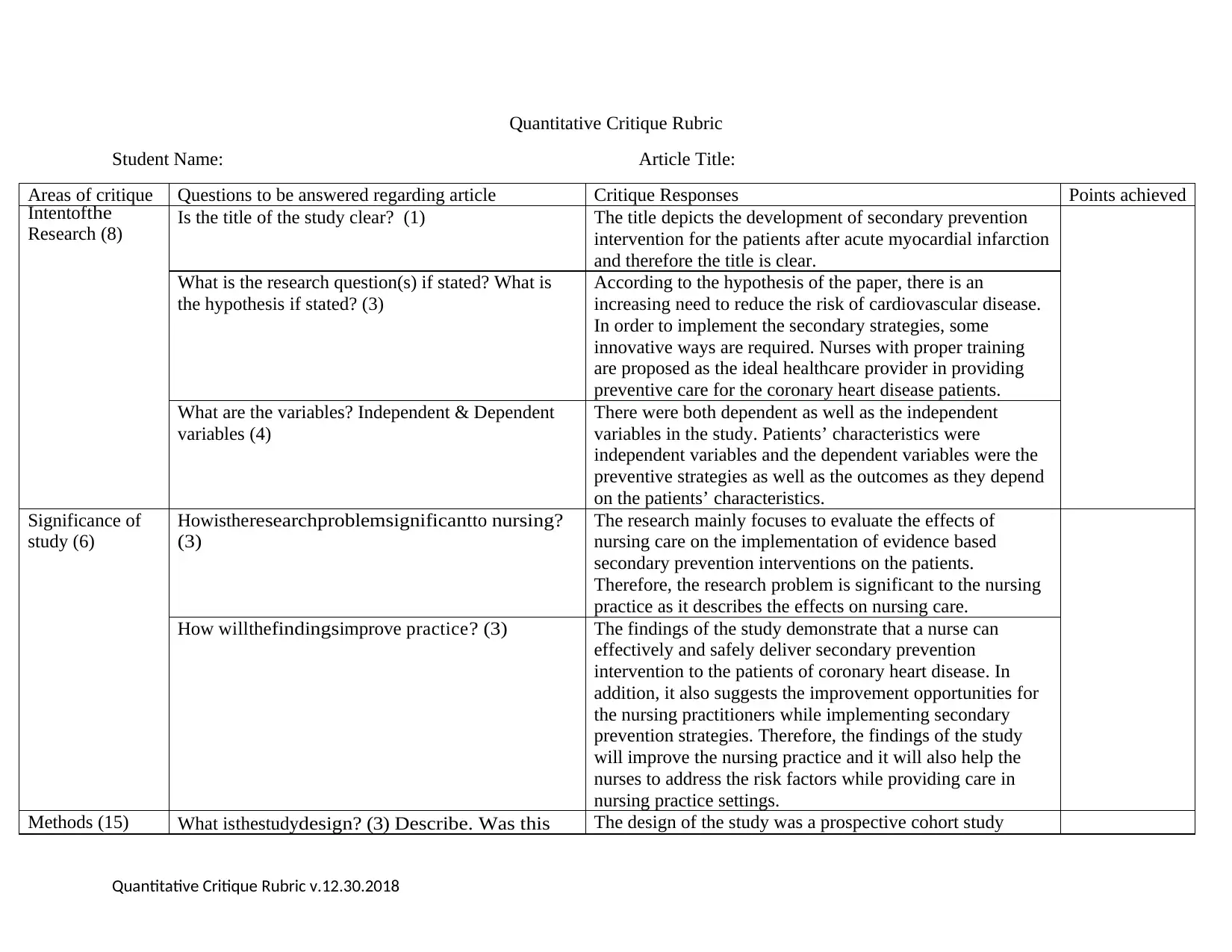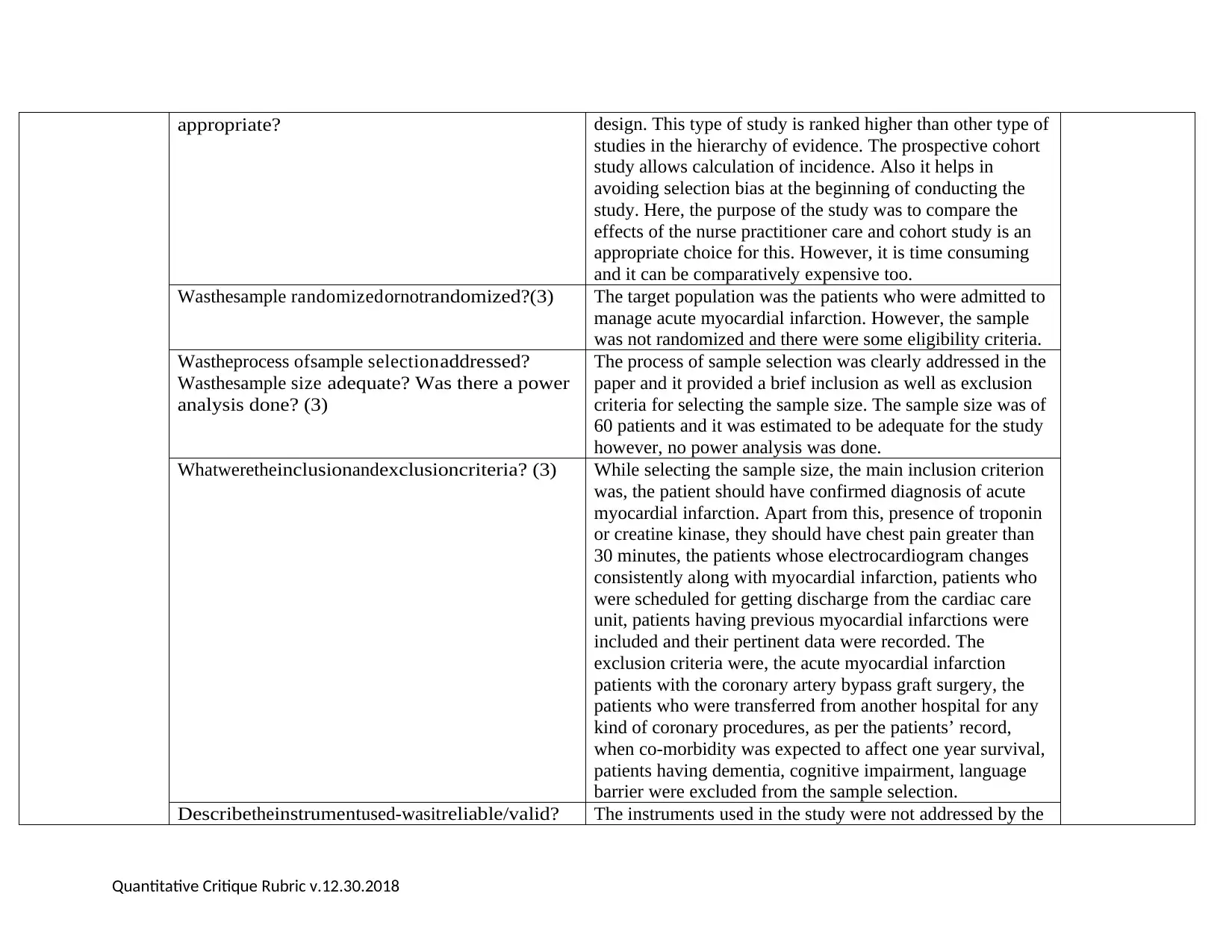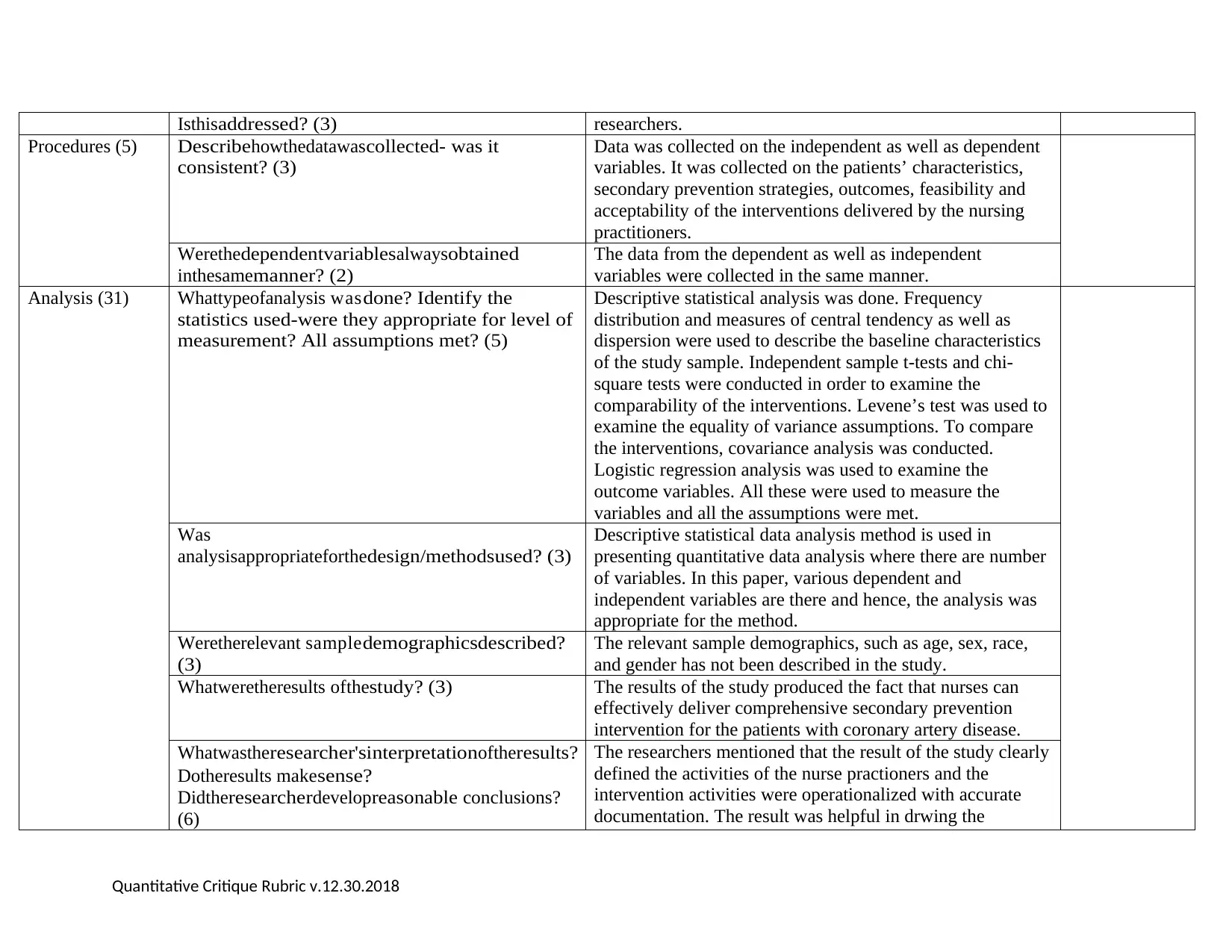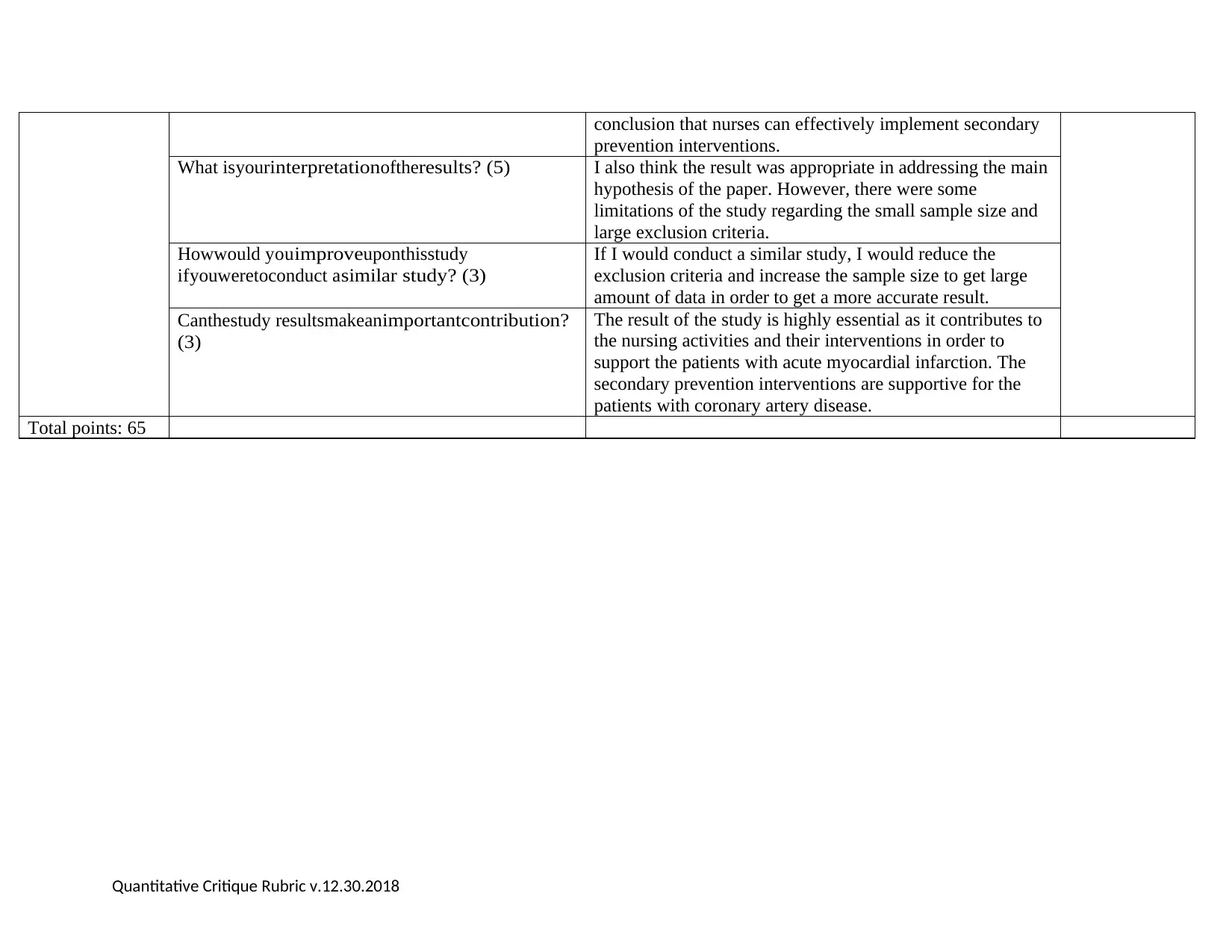NURS 300: Quantitative Critique of a Research Article
VerifiedAdded on 2023/01/10
|4
|1221
|25
Homework Assignment
AI Summary
This assignment is a quantitative critique of a nursing research article focused on secondary prevention interventions for patients after acute myocardial infarction. The critique, structured around a rubric, evaluates the study's intent, significance, methods (including study design, sample selection, inclusion/exclusion criteria, and instruments), procedures, and analysis. The analysis includes a review of the statistical methods used, the appropriateness of the analysis for the study design, the presentation of results, and the researcher's interpretations. The critique also offers an interpretation of the results and suggestions for improving the study. The study's findings suggest that nurses can effectively deliver secondary prevention interventions, contributing to improved patient outcomes. However, the critique points out limitations, such as a small sample size and extensive exclusion criteria. The overall contribution of the study to nursing practice is highlighted, emphasizing its importance in supporting patients with coronary artery disease.

Quantitative Critique Rubric
Student Name: Article Title:
Areas of critique Questions to be answered regarding article Critique Responses Points achieved
Intentof the
Research (8) Is the title of the study clear? (1) The title depicts the development of secondary prevention
intervention for the patients after acute myocardial infarction
and therefore the title is clear.
What is the research question(s) if stated? What is
the hypothesis if stated? (3)
According to the hypothesis of the paper, there is an
increasing need to reduce the risk of cardiovascular disease.
In order to implement the secondary strategies, some
innovative ways are required. Nurses with proper training
are proposed as the ideal healthcare provider in providing
preventive care for the coronary heart disease patients.
What are the variables? Independent & Dependent
variables (4)
There were both dependent as well as the independent
variables in the study. Patients’ characteristics were
independent variables and the dependent variables were the
preventive strategies as well as the outcomes as they depend
on the patients’ characteristics.
Significance of
study (6)
Howisthe researchproblemsignificantto nursing?
(3)
The research mainly focuses to evaluate the effects of
nursing care on the implementation of evidence based
secondary prevention interventions on the patients.
Therefore, the research problem is significant to the nursing
practice as it describes the effects on nursing care.
How willthefindingsimprove practice ? (3) The findings of the study demonstrate that a nurse can
effectively and safely deliver secondary prevention
intervention to the patients of coronary heart disease. In
addition, it also suggests the improvement opportunities for
the nursing practitioners while implementing secondary
prevention strategies. Therefore, the findings of the study
will improve the nursing practice and it will also help the
nurses to address the risk factors while providing care in
nursing practice settings.
Methods (15) What isthestudy design? (3) Describe. Was this The design of the study was a prospective cohort study
Quantitative Critique Rubric v.12.30.2018
Student Name: Article Title:
Areas of critique Questions to be answered regarding article Critique Responses Points achieved
Intentof the
Research (8) Is the title of the study clear? (1) The title depicts the development of secondary prevention
intervention for the patients after acute myocardial infarction
and therefore the title is clear.
What is the research question(s) if stated? What is
the hypothesis if stated? (3)
According to the hypothesis of the paper, there is an
increasing need to reduce the risk of cardiovascular disease.
In order to implement the secondary strategies, some
innovative ways are required. Nurses with proper training
are proposed as the ideal healthcare provider in providing
preventive care for the coronary heart disease patients.
What are the variables? Independent & Dependent
variables (4)
There were both dependent as well as the independent
variables in the study. Patients’ characteristics were
independent variables and the dependent variables were the
preventive strategies as well as the outcomes as they depend
on the patients’ characteristics.
Significance of
study (6)
Howisthe researchproblemsignificantto nursing?
(3)
The research mainly focuses to evaluate the effects of
nursing care on the implementation of evidence based
secondary prevention interventions on the patients.
Therefore, the research problem is significant to the nursing
practice as it describes the effects on nursing care.
How willthefindingsimprove practice ? (3) The findings of the study demonstrate that a nurse can
effectively and safely deliver secondary prevention
intervention to the patients of coronary heart disease. In
addition, it also suggests the improvement opportunities for
the nursing practitioners while implementing secondary
prevention strategies. Therefore, the findings of the study
will improve the nursing practice and it will also help the
nurses to address the risk factors while providing care in
nursing practice settings.
Methods (15) What isthestudy design? (3) Describe. Was this The design of the study was a prospective cohort study
Quantitative Critique Rubric v.12.30.2018
Paraphrase This Document
Need a fresh take? Get an instant paraphrase of this document with our AI Paraphraser

appropriate? design. This type of study is ranked higher than other type of
studies in the hierarchy of evidence. The prospective cohort
study allows calculation of incidence. Also it helps in
avoiding selection bias at the beginning of conducting the
study. Here, the purpose of the study was to compare the
effects of the nurse practitioner care and cohort study is an
appropriate choice for this. However, it is time consuming
and it can be comparatively expensive too.
Wasthesample randomizedornotrandomized?(3) The target population was the patients who were admitted to
manage acute myocardial infarction. However, the sample
was not randomized and there were some eligibility criteria.
Wastheprocess ofsample selection addressed?
Wasthesample size adequate? Was there a power
analysis done? (3)
The process of sample selection was clearly addressed in the
paper and it provided a brief inclusion as well as exclusion
criteria for selecting the sample size. The sample size was of
60 patients and it was estimated to be adequate for the study
however, no power analysis was done.
Whatwerethe inclusionand exclusioncriteria? (3) While selecting the sample size, the main inclusion criterion
was, the patient should have confirmed diagnosis of acute
myocardial infarction. Apart from this, presence of troponin
or creatine kinase, they should have chest pain greater than
30 minutes, the patients whose electrocardiogram changes
consistently along with myocardial infarction, patients who
were scheduled for getting discharge from the cardiac care
unit, patients having previous myocardial infarctions were
included and their pertinent data were recorded. The
exclusion criteria were, the acute myocardial infarction
patients with the coronary artery bypass graft surgery, the
patients who were transferred from another hospital for any
kind of coronary procedures, as per the patients’ record,
when co-morbidity was expected to affect one year survival,
patients having dementia, cognitive impairment, language
barrier were excluded from the sample selection.
Describethe instrumentused-wasit reliable/valid? The instruments used in the study were not addressed by the
Quantitative Critique Rubric v.12.30.2018
studies in the hierarchy of evidence. The prospective cohort
study allows calculation of incidence. Also it helps in
avoiding selection bias at the beginning of conducting the
study. Here, the purpose of the study was to compare the
effects of the nurse practitioner care and cohort study is an
appropriate choice for this. However, it is time consuming
and it can be comparatively expensive too.
Wasthesample randomizedornotrandomized?(3) The target population was the patients who were admitted to
manage acute myocardial infarction. However, the sample
was not randomized and there were some eligibility criteria.
Wastheprocess ofsample selection addressed?
Wasthesample size adequate? Was there a power
analysis done? (3)
The process of sample selection was clearly addressed in the
paper and it provided a brief inclusion as well as exclusion
criteria for selecting the sample size. The sample size was of
60 patients and it was estimated to be adequate for the study
however, no power analysis was done.
Whatwerethe inclusionand exclusioncriteria? (3) While selecting the sample size, the main inclusion criterion
was, the patient should have confirmed diagnosis of acute
myocardial infarction. Apart from this, presence of troponin
or creatine kinase, they should have chest pain greater than
30 minutes, the patients whose electrocardiogram changes
consistently along with myocardial infarction, patients who
were scheduled for getting discharge from the cardiac care
unit, patients having previous myocardial infarctions were
included and their pertinent data were recorded. The
exclusion criteria were, the acute myocardial infarction
patients with the coronary artery bypass graft surgery, the
patients who were transferred from another hospital for any
kind of coronary procedures, as per the patients’ record,
when co-morbidity was expected to affect one year survival,
patients having dementia, cognitive impairment, language
barrier were excluded from the sample selection.
Describethe instrumentused-wasit reliable/valid? The instruments used in the study were not addressed by the
Quantitative Critique Rubric v.12.30.2018

Isthis addressed? (3) researchers.
Procedures (5) Describehowthedatawas collected- was it
consistent? (3)
Data was collected on the independent as well as dependent
variables. It was collected on the patients’ characteristics,
secondary prevention strategies, outcomes, feasibility and
acceptability of the interventions delivered by the nursing
practitioners.
Werethe dependentvariablesalways obtained
inthesame manner? (2)
The data from the dependent as well as independent
variables were collected in the same manner.
Analysis (31) Whattypeofanalysis was done? Identify the
statistics used-were they appropriate for level of
measurement? All assumptions met? (5)
Descriptive statistical analysis was done. Frequency
distribution and measures of central tendency as well as
dispersion were used to describe the baseline characteristics
of the study sample. Independent sample t-tests and chi-
square tests were conducted in order to examine the
comparability of the interventions. Levene’s test was used to
examine the equality of variance assumptions. To compare
the interventions, covariance analysis was conducted.
Logistic regression analysis was used to examine the
outcome variables. All these were used to measure the
variables and all the assumptions were met.
Was
analysisappropriateforthe design/methodsused? (3)
Descriptive statistical data analysis method is used in
presenting quantitative data analysis where there are number
of variables. In this paper, various dependent and
independent variables are there and hence, the analysis was
appropriate for the method.
Weretherelevant sample demographicsdescribed?
(3)
The relevant sample demographics, such as age, sex, race,
and gender has not been described in the study.
Whatweretheresults ofthestudy? (3) The results of the study produced the fact that nurses can
effectively deliver comprehensive secondary prevention
intervention for the patients with coronary artery disease.
Whatwasthe researcher'sinterpretationoftheresults?
Dotheresults make sense?
Didtheresearcherdevelop reasonable conclusions?
(6)
The researchers mentioned that the result of the study clearly
defined the activities of the nurse practioners and the
intervention activities were operationalized with accurate
documentation. The result was helpful in drwing the
Quantitative Critique Rubric v.12.30.2018
Procedures (5) Describehowthedatawas collected- was it
consistent? (3)
Data was collected on the independent as well as dependent
variables. It was collected on the patients’ characteristics,
secondary prevention strategies, outcomes, feasibility and
acceptability of the interventions delivered by the nursing
practitioners.
Werethe dependentvariablesalways obtained
inthesame manner? (2)
The data from the dependent as well as independent
variables were collected in the same manner.
Analysis (31) Whattypeofanalysis was done? Identify the
statistics used-were they appropriate for level of
measurement? All assumptions met? (5)
Descriptive statistical analysis was done. Frequency
distribution and measures of central tendency as well as
dispersion were used to describe the baseline characteristics
of the study sample. Independent sample t-tests and chi-
square tests were conducted in order to examine the
comparability of the interventions. Levene’s test was used to
examine the equality of variance assumptions. To compare
the interventions, covariance analysis was conducted.
Logistic regression analysis was used to examine the
outcome variables. All these were used to measure the
variables and all the assumptions were met.
Was
analysisappropriateforthe design/methodsused? (3)
Descriptive statistical data analysis method is used in
presenting quantitative data analysis where there are number
of variables. In this paper, various dependent and
independent variables are there and hence, the analysis was
appropriate for the method.
Weretherelevant sample demographicsdescribed?
(3)
The relevant sample demographics, such as age, sex, race,
and gender has not been described in the study.
Whatweretheresults ofthestudy? (3) The results of the study produced the fact that nurses can
effectively deliver comprehensive secondary prevention
intervention for the patients with coronary artery disease.
Whatwasthe researcher'sinterpretationoftheresults?
Dotheresults make sense?
Didtheresearcherdevelop reasonable conclusions?
(6)
The researchers mentioned that the result of the study clearly
defined the activities of the nurse practioners and the
intervention activities were operationalized with accurate
documentation. The result was helpful in drwing the
Quantitative Critique Rubric v.12.30.2018
⊘ This is a preview!⊘
Do you want full access?
Subscribe today to unlock all pages.

Trusted by 1+ million students worldwide

conclusion that nurses can effectively implement secondary
prevention interventions.
What isyour interpretationoftheresults? (5) I also think the result was appropriate in addressing the main
hypothesis of the paper. However, there were some
limitations of the study regarding the small sample size and
large exclusion criteria.
Howwould you improveuponthisstudy
ifyouweretoconduct a similar study? (3)
If I would conduct a similar study, I would reduce the
exclusion criteria and increase the sample size to get large
amount of data in order to get a more accurate result.
Canthestudy resultsmakean importantcontribution?
(3)
The result of the study is highly essential as it contributes to
the nursing activities and their interventions in order to
support the patients with acute myocardial infarction. The
secondary prevention interventions are supportive for the
patients with coronary artery disease.
Total points: 65
Quantitative Critique Rubric v.12.30.2018
prevention interventions.
What isyour interpretationoftheresults? (5) I also think the result was appropriate in addressing the main
hypothesis of the paper. However, there were some
limitations of the study regarding the small sample size and
large exclusion criteria.
Howwould you improveuponthisstudy
ifyouweretoconduct a similar study? (3)
If I would conduct a similar study, I would reduce the
exclusion criteria and increase the sample size to get large
amount of data in order to get a more accurate result.
Canthestudy resultsmakean importantcontribution?
(3)
The result of the study is highly essential as it contributes to
the nursing activities and their interventions in order to
support the patients with acute myocardial infarction. The
secondary prevention interventions are supportive for the
patients with coronary artery disease.
Total points: 65
Quantitative Critique Rubric v.12.30.2018
1 out of 4
Related Documents
Your All-in-One AI-Powered Toolkit for Academic Success.
+13062052269
info@desklib.com
Available 24*7 on WhatsApp / Email
![[object Object]](/_next/static/media/star-bottom.7253800d.svg)
Unlock your academic potential
Copyright © 2020–2025 A2Z Services. All Rights Reserved. Developed and managed by ZUCOL.





